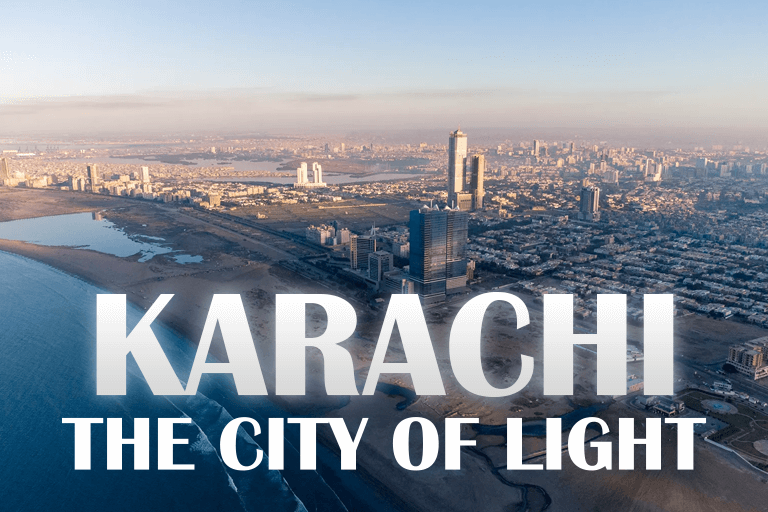Introduction
Karachi, the largest and most populous city of Pakistan, is not just the country’s financial capital but also a hub of culture, history, and resilience. Known as the “City of Lights,” Karachi has grown from a small fishing village into one of the world’s fastest-growing megacities. From the shores of the Arabian Sea to its bustling streets filled with diversity, Karachi represents the heartbeat of Pakistan — a city that never sleeps.
Historical Background of Karachi
Karachi’s history dates back several centuries. Originally, it was a small fishing settlement known as Kolachi, named after a fisherwoman called “Mai Kolachi.”
During the 18th century, it evolved into a fortified town as trade routes began to flourish along the Arabian coast.
The British East India Company captured Karachi in 1839, recognizing its strategic importance as a seaport. Under British rule, Karachi was transformed into a modern port city, serving as the gateway to India. Railways, docks, and roads were built, making it one of South Asia’s busiest trading hubs.
When Pakistan gained independence in 1947, Karachi became the first capital of the new nation. The city experienced massive migration, with millions of refugees settling here, shaping its multicultural identity that remains to this day.
Cultural Diversity and Lifestyle
Karachi is a melting pot of ethnicities, languages, and cultures. People from all provinces — Sindh, Punjab, Balochistan, and Khyber Pakhtunkhwa — live here alongside communities of Muhajirs, Parsis, Memons, Bohras, and Christians.
Urdu is widely spoken, but you’ll hear Sindhi, Punjabi, Pashto, and Balochi in every corner.
This diversity gives Karachi its rich cultural blend — reflected in its food, festivals, art, and architecture. From burns road biryani to clifton sea view strolls, Karachi offers a mix of modern and traditional experiences.
The city’s nightlife, shopping centers, and beachside cafés add to its charm, while cultural institutions like NAPA, Arts Council of Pakistan, and T2F promote creativity and dialogue.
Economic Powerhouse of Pakistan
Karachi is the financial and industrial backbone of Pakistan. The city contributes nearly 20% of Pakistan’s GDP and handles 95% of international trade through its ports — Karachi Port and Port Qasim.
It houses the headquarters of major national and multinational companies, stock exchanges, and banks. From textile mills to tech startups, Karachi’s economic activity never stops.
The Karachi Stock Exchange (KSE), now part of Pakistan Stock Exchange (PSX), is the largest in the country and a key indicator of the nation’s economy.
The city’s industrial zones, including Korangi, SITE, and Bin Qasim Industrial Area, employ millions and attract investors from across the globe.
Education and Institutions
Karachi is also a center of learning, home to some of the top educational institutions in Pakistan:
- University of Karachi (UoK)
- Institute of Business Administration (IBA)
- NED University of Engineering and Technology
- Aga Khan University (AKU)
- Dow University of Health Sciences (DUHS)
These institutions have produced thousands of professionals contributing globally in medicine, engineering, and business.
Tourist Attractions in Karachi
Karachi offers a variety of attractions for tourists and locals alike:
- Clifton Beach & Hawksbay – popular for family outings and sunsets
- Mazar-e-Quaid – the resting place of Quaid-e-Azam Muhammad Ali Jinnah
- Mohatta Palace – a glimpse of colonial-era architecture
- Pakistan Maritime Museum and Quaid’s House Museum
- Dolmen Mall and Lucky One Mall – modern shopping destinations
- Karachi Arts Council and PNCA Karachi – cultural centers hosting art, theater, and music events
From beaches to bustling markets like Zainab Market and Saddar, Karachi blends the old and the new in a uniquely energetic way.
Challenges and Modern Development
Like every megacity, Karachi faces challenges — traffic congestion, population pressure, infrastructure strain, and law-and-order issues. However, in recent years, major development projects have aimed to improve the city’s landscape:
- Green Line BRT Project for mass transit
- K-IV Water Supply Scheme to address water shortage
- Smart City projects and waste management initiatives
Private sectors are investing heavily in real estate, with skyscrapers like Bahria Icon Tower and modern housing societies reshaping Karachi’s skyline.
Despite its hurdles, Karachi’s resilience stands unmatched. The people of this city rebuild and rise stronger every time — whether after political turmoil or natural challenges.
Weather and Climate
Karachi enjoys a moderate coastal climate, making it warmer in winter and humid in summer. Average summer temperatures range from 30°C to 36°C, while winters remain mild around 15°C to 25°C.
Occasional monsoon rains and sea breezes keep the weather balanced, making Karachi livable year-round.
The Future of Karachi
With ongoing urban renewal projects, digital transformation, and increased investment, Karachi is set to become one of South Asia’s major metropolitan smart cities by 2035. The CPEC (China-Pakistan Economic Corridor) is also expected to strengthen Karachi’s port connectivity and logistics network, boosting trade and employment.
Karachi’s youth-driven entrepreneurship and tech innovation, especially in areas like fintech and e-commerce, continue to redefine the city’s future.
Conclusion
Karachi is more than just Pakistan’s largest city — it’s a symbol of ambition, endurance, and diversity. From the humble fishing village of Kolachi to the sprawling metropolis it is today, Karachi represents the soul of Pakistan’s progress.
Its roads may be crowded and its challenges many, but the spirit of Karachiites — vibrant, hopeful, and unbreakable — keeps the City of Lights shining bright.

